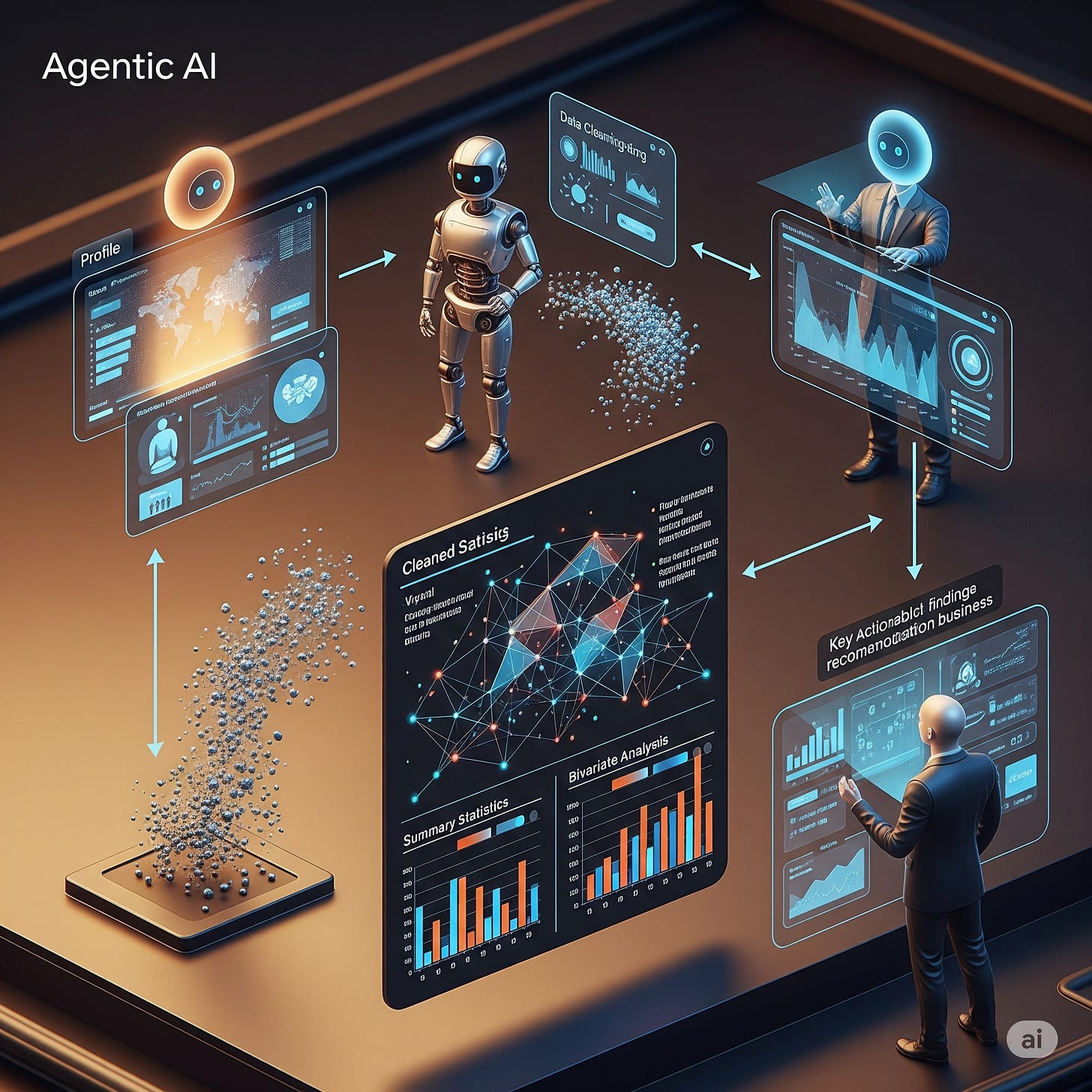Data Analysis with Agentic AI (Part 3 - Agentic Workflow)
The Agentic Heartbeat: A Deep Dive into Automated Data Analysis Nodes
Introduction
In Part 2, we laid out the comprehensive architecture and modular project structure of our LangGraph-powered agentic data analysis system. You now understand the blueprint that allows our intelligent agents to operate.
Get ready to truly understand the "how" behind the automation! In this part, we'll dive deep into each specialized agent node, revealing its unique mission, how it leverages LLMs for intelligent decision-making, and how it interacts with tools to perform complex data tasks. You'll see how these individual components come together to form a seamless, automated data analysis pipeline.
For those who would like to dive deep into the Python code and run it themselves, here is the GitHub repo.
About the Author:
Arun Subramanian: Arun is an Associate Principal of Analytics & Insights at Amazon Ads, where he leads development and deployment of innovative insights to optimize advertising performance at scale. He has over 12 years of experience and is skilled in crafting strategic analytics roadmap, nurturing talent, collaborating with cross-functional teams, and communicating complex insights to diverse stakeholders.
The Agentic Core: Nodes and Their Missions
Each node in our LangGraph workflow is more than just a function; it's a specialized AI agent, equipped with the intelligence to perform a specific data analysis task. This multi-agent collaboration is what truly mimics a human data scientist's approach, ensuring a thorough and systematic analysis.
1. Data Profiling Node (node_data_profiling.py):
Mission: This is where your data's journey begins. Upon upload, this ReAct agent meticulously profiles your dataset. It's like a detective, that leverages key statistics (mean, median, mode, standard deviation), data types, etc. to identify potential data quality issues such as missing values, outliers, and inconsistencies.
How it Leverages LLM: The LLM within this node reasons about the data's characteristics and identifies potential problems and recommends relevant actions to resolve them.
Output: Its output isn't just raw numbers; it's a concise report with actionable recommendations for cleaning, setting the stage for the next phase.
2. Data Cleaning Node (node_data_cleaning.py):
Mission: Armed with the profiling node's recommendations, this powerful ReAct agent springs into action. Its mission is to make your data pristine and ready for robust analysis.
How it Leverages LLM & Tools: Using its LLM brain, it reasons about the best cleaning strategies (e.g., optimal imputation methods for missing values, robust outlier treatment techniques like Winsorization or removal, or necessary data type conversions like converting strings to numerical values). Then, it dynamically generates the precise Python code to execute these cleaning steps within the secure
coding_tool.pysandbox. This ensures your data is transformed intelligently and accurately.Output: A cleaned Pandas DataFrame, ready for the next analytical steps, along with a detailed log of all cleaning operations performed.
3. Summary Statistics Node (node_summary_statistics.py):
Mission: This node specifically focuses on generating comprehensive descriptive statistics for all relevant numerical and categorical variables using the cleaned dataset. It provides a quick, yet thorough, overview of your dataset's central tendencies, spread, and basic distributions.
How it Leverages LLM: The LLM helps build a comprehensive report on observations from the summary statistics table.
Output: A well-defined report on key summary statistics and its implications.
4. Univariate & Bivariate Analysis Node (node_univariate_analysis.py & node_bivariate_analysis.py):
Mission: With clean data in hand, these agents focus on understanding individual variables and then the relationships between pairs of variables.
Univariate Analysis: This agent dives into individual variables. It generates insightful visualizations like histograms, box plots, and density plots to understand data distributions for each feature.
Bivariate Analysis: Moving beyond individual variables, this agent explores the relationships between pairs of variables. It might calculate correlation matrices, generate scatter plots, perform cross-tabulations to uncover patterns, dependencies, and potential drivers within your dataset. This is where deeper, more interconnected insights begin to emerge.
How it Leverages LLMs: The LLM gleans key findings and generates a summary of insights from each visualization created in these nodes.
Output: A collection of high-quality visualizations along with a comprehensive summary of key insights from each analysis performed.
5. Final Report Node (node_final_report.py):
Mission: The culmination of the entire workflow! This agent synthesizes all the findings from the previous stages—summary statistics, univariate and bivariate analyses, and all generated visualizations. Its ultimate goal is to provide clear, data-driven, and actionable recommendations.
How it Leverages LLM: The LLM acts as a summarization and recommendation engine. It takes the vast amount of intermediate data, analysis results, and visualizations, then processes them to identify key trends, anomalies, and opportunities. It structures this information into a coherent narrative, focusing on the "so what?" for the business user.
Output: A comprehensive, human-readable markdown report, complete with clear, data-driven, and actionable recommendations tailored to your key metrics. This report is designed to be immediately useful for decision-making.
This collaborative approach, where each agent passes its refined knowledge to the next, ensures a thorough and systematic analysis, just like a team of expert data scientists working in harmony.
Conclusion
You've now taken a deep dive into the heart of our agentic workflow, understanding the specialized missions of each node and how they collaborate to deliver comprehensive data analysis.
Next up: "Key Learnings and Recommendations: Our Journey, Your Blueprint" – where I will share the invaluable lessons learned on this pioneering journey, and provide insights to help you build your own robust agentic systems!


